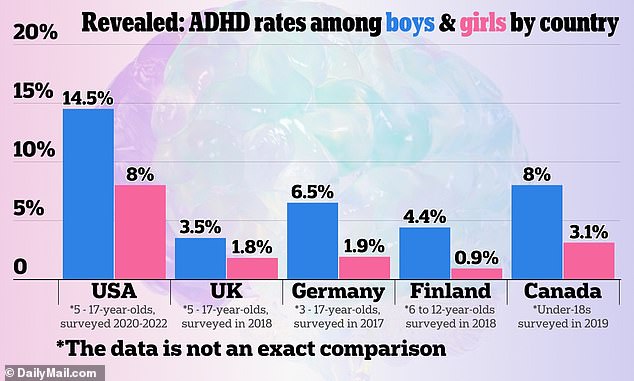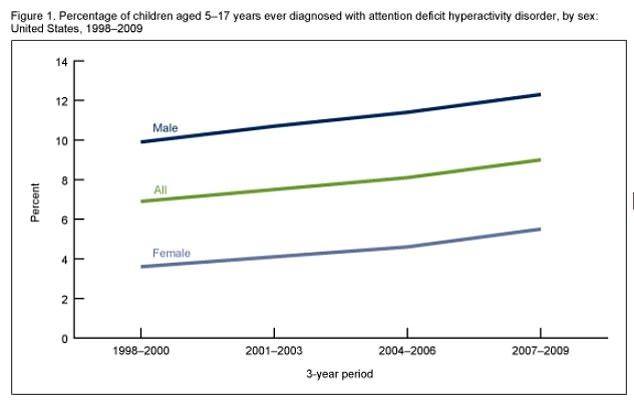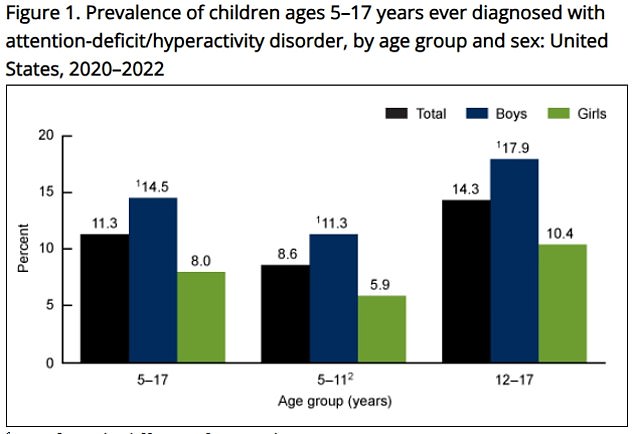One in seven boys in the US now suffer from attention deficit hyperactivity disorder, a shocking government report suggests – while diagnoses are up to triple those in European countries.
A CDC-led report found that 14.5 percent of American boys have a developmental problem related to poor concentration, up from just under ten percent in 2000.
For boys and girls aged five to 17 combined, the prevalence was 11.3 percent, or about one in ten.
Nearly twice as many boys suffered from the condition as girls, while those from white backgrounds and with health insurance were also more likely to receive the diagnosis.
The new US figures are very different from those in other countries, including the United Kingdom, where it is estimated that around 3% of boys and less than 2% of girls are diagnosed with the condition.

The chart above shows ADHD rates in the United States compared to other countries.
In Germany, rates among boys are around 6%, according to a 2019 study by researchers in the country. Robert Koch Institute.
And in the UK, around 3.6% of boys suffer from the condition, according to a 2023 study.
The rising rates of ADHD come amid warnings from psychologists that the prevalence in the United States is far too high and is causing many children to unnecessarily take medications used to treat the condition.
The market value of ADHD drugs such as Adderall and Ritalin more than tripled in the 12 years to 2022, reaching $12.5 billion. Estimates suggest that this amount could reach almost $15 billion by 2030.
The late Dr. Keith Connors was a former Harvard University psychologist who published the first diagnostic standards for ADHD in the 1990s.
“The figures give the impression of an epidemic,” he said in 2013, five years before his death. “Well, that’s not the case. It’s absurd.
“This is a concoction intended to justify the administration of drugs at unprecedented and unjustifiable levels.”
ADHD is defined as a neurodevelopmental disorder that affects an individual’s ability to concentrate, control impulses, and regulate energy levels.
It is usually diagnosed during childhood, around the age of six or seven, but in many cases persists into adolescence and adulthood.


The chart above, from the 2009 CDC report, shows the gradual increase in ADHD diagnoses among children. Among boys it is now 14.5 percent


The above, from the most recent CDC report, shows the proportion of children never diagnosed, broken down by age group and gender.
Treatments include stimulant medications, including Adderall and Ritalin, which work by changing the levels of chemicals in the brain to improve focus and attention.
But the drugs also have unpleasant side effects, including insomnia, increased irritability and increased anxiety. In severe cases, they can cause seizures, hallucinations and psychoses.
The CDC-led report — the first update of these numbers since 2009 — highlighted how rates of ADHD in children have skyrocketed in the United States over the past few decades.
In the 1990s, an estimated 600,000 children were diagnosed with ADHD, putting diagnosis rates on par with other countries.
But by 2009, the prevalence had increased from six to eight percent and reached 12 percent among young boys.
The latest report, based on data from the National Health Interview Survey (NHIS), shows how diagnosis rates in the United States have continued to rise well above levels in other countries.
The NHIS surveys a nationally representative sample of 8,400 children each year, in person and by telephone, about their health, including whether they have been diagnosed with ADHD and whether they are receiving treatment for the condition. .
Dr Scott Lyons, a psychologist from the Bronx, New York, told DailyMail.com: “The prevalence rates clearly identified a financial component.
“The diagnostic criteria have not changed.
“And we can’t just say that people are more willing to diagnose this disease because the criteria have stayed the same.”
The report also found that rates of this condition were higher among white children (13.4%) than among black (10.8%) and Hispanic (8.9%) children.
They were also higher among children with health insurance (up to 14.4 percent) than among those without insurance (6.3 percent).
Researchers have previously suggested that pharmaceutical companies’ marketing campaigns have broadened the definition of ADHD to include relatively normal childhood behaviors, such as carelessness and impatience.
The FDA has already accused every major ADHD drug of false and misleading advertising since 2000, some multiple times.
Medications used to treat ADHD are now the most commonly prescribed medications for children.
Several studies and experts have warned that many children are being misdiagnosed with ADHD.
When children start school, some may be just five years old, while others may be almost six years old, representing a 20 percent difference in natural development, experts say.
Dr. Todd Elder, a health economist at Michigan State University, previously said, “If a child is misbehaving, if they’re inattentive, if they can’t sit still, it could be – be simply because he is five and the other children are six.
“There is a big difference between a five-year-old and a six-year-old, and teachers and doctors need to take that into account when assessing whether children have ADHD.”

